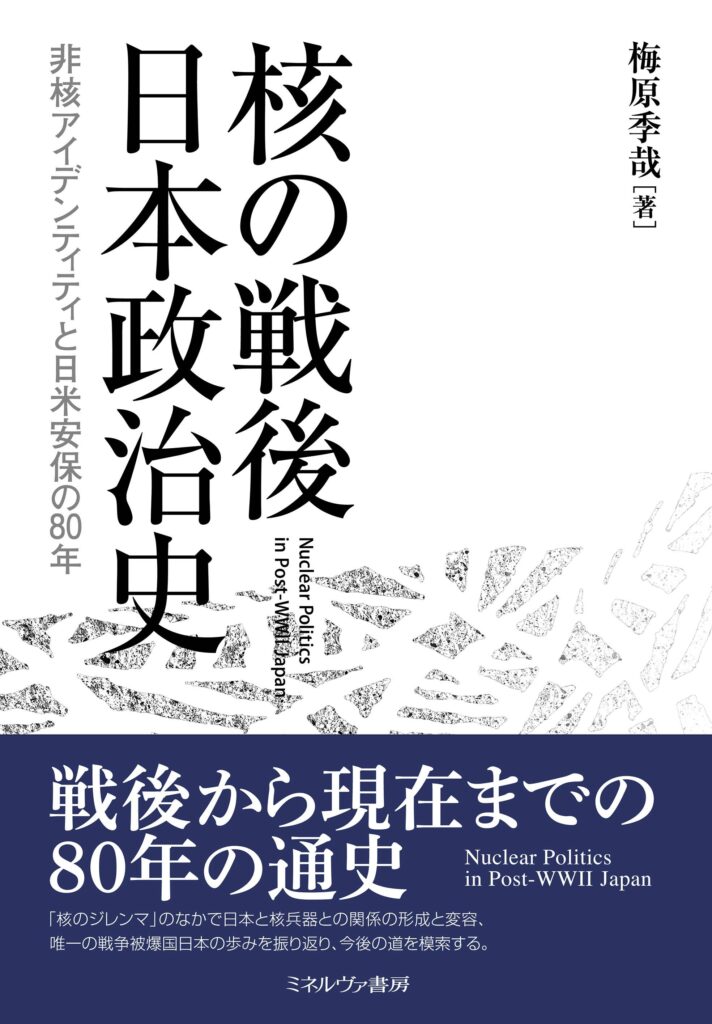梅原 季哉(教授)

ミネルヴァ書房、2025年10月刊行、
定価:6,050円(税込)
日本は世界で唯一の「被爆国」と自ら任じ、戦後一貫して平和主義と核兵器忌避の姿勢を国のアイデンティティとしてきました。しかし一方で、日本政府は同盟国である米国の拡大核抑止(いわゆる「核の傘」)の下での核兵器使用の可能性を公式に否定したことはありません。こうした矛盾はなぜ生じ、どう展開してきたのでしょうか。この問いに取り組んだのが、私の新著『核の戦後日本政治史————非核アイデンティティと日米安保の80年』です。
本書では、国際関係論における構成主義の理論的枠組みを用いて、戦後日本が「核使用禁止規範(いわゆる“核のタブー”)」と「核不拡散規範」という二つの国際規範を、いかに異なるかたちで内在化してきたのか、一次史料をもとに実証的に探りました。そこから浮かび上がってきたのは、日本の政策当局が核不拡散規範を国家アイデンティティの中核、行動規範として受け入れてきた一方で、「核のタブー」については構成的・道徳的な規範として受容姿勢を示しつつも、政策的な規制、拘束力を持たせることを回避してきた状況です。
例えば、冒頭部で扱っている占領下の日本では、潜在的な核研究計画がGHQによって解体され、核不拡散規範は厳密に執行されました。その一方で、広島・長崎の原爆被爆について検閲体制が敷かれ、「核のタブー」の前提となる知識の伝播が妨げられました。さらに、戦時中の日本のエリート層が「原爆が戦争を終わらせた」という物語を受け入れることで、ソ連による和平仲介への期待を持ち続けていたという不都合な事実は覆い隠されました。今につながる選択的な内在化と、不可視化を促した原点の時代といえます。本書ではその後の各章を通して、冷戦期を通じての同盟政治上の駆け引きや、冷戦後現在までの日本を取り巻く、北朝鮮の核開発やウクライナ戦争といった国際危機の影響を、通史として分析しています。この80年間の日本の姿を正確に認識し、今後を考える一助となればと考えています。
Nuclear Politics in Post-WWII Japan [Kaku no Sengo Nihon Seijishi]
Toshiya Umehara (Professor)

Minerva Shobo, in October 2025. Price: 6,050 yen (including tax)
*This article is forthcoming in the 68th issue of Hiroshima Research News.
Click here to see past issues of the Newsletter.
Please also refer to the Publications page.
Japan has long regarded itself as the world’s only Hibakukoku (“A-bombed nation”), building its postwar identity on pacifism and a deep aversion to nuclear weapons. Yet, at the same time, the Japanese government has never officially denied the possible use of nuclear weapons by the United States, its ally, under the framework of extended nuclear deterrence—the so-called “nuclear umbrella.” Why has this contradiction emerged, and how has it evolved over the eight decades since Hiroshima and Nagasaki?
These are the central questions explored in my new book, Kaku no Sengo Nihon Seijishi (Nuclear Politics in Post–WWII Japan), published by Minerva Shobo in October 2025. Using the theoretical framework of constructivist international relations, the book examines how postwar Japan internalized two international norms in strikingly different ways—the nuclear non-use norm (the so-called “nuclear taboo”) and the nonproliferation norm—empirically drawing on a wide range of primary sources. The analysis reveals that Japan’s policymakers came to embrace the nonproliferation norm as a central part of the nation’s postwar identity and as a binding rule of conduct. In contrast, the “nuclear taboo” was accepted mainly as a moral or constitutive principle—acknowledged on rhetorical and symbolical bases, but deliberately kept it from acquiring real policy-binding or regulatory force.
For example, Chapter 1 of the book focuses on occupied Japan, where the U.S. occupying force dismantled Japan’s latent nuclear research program, rigorously enforcing the nonproliferation norm from the outset. Meanwhile, strict censorship under the occupation prevented the spread of information about the devastation of Hiroshima and Nagasaki, hindering the initial foundations in the society for a robust “nuclear taboo.” Furthermore, wartime Japanese elites tacitly embraced the narrative that the atomic bombings had “ended the war,” partly to conceal the inconvenient fact that Japan had continued to seek Soviet mediation until the USSR broke neutrality and invaded Manchuria on the same day as the Nagasaki bombing. This early period marked the origin of Japan’s selective internalization of nuclear norms—and the lasting invisibility surrounding nuclear use.
Subsequent chapters trace this trajectory through Cold War alliance politics and into the present, analyzing how Japan has navigated challenges such as North Korea’s nuclear development and Russia’s war in Ukraine. I hope this book offers readers a clearer understanding of how Japan became both symbolically anti-nuclear and strategically reliant on nuclear deterrence—and what that dual legacy means for the future.
